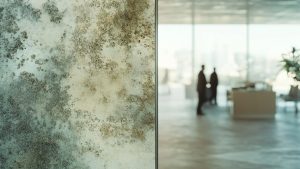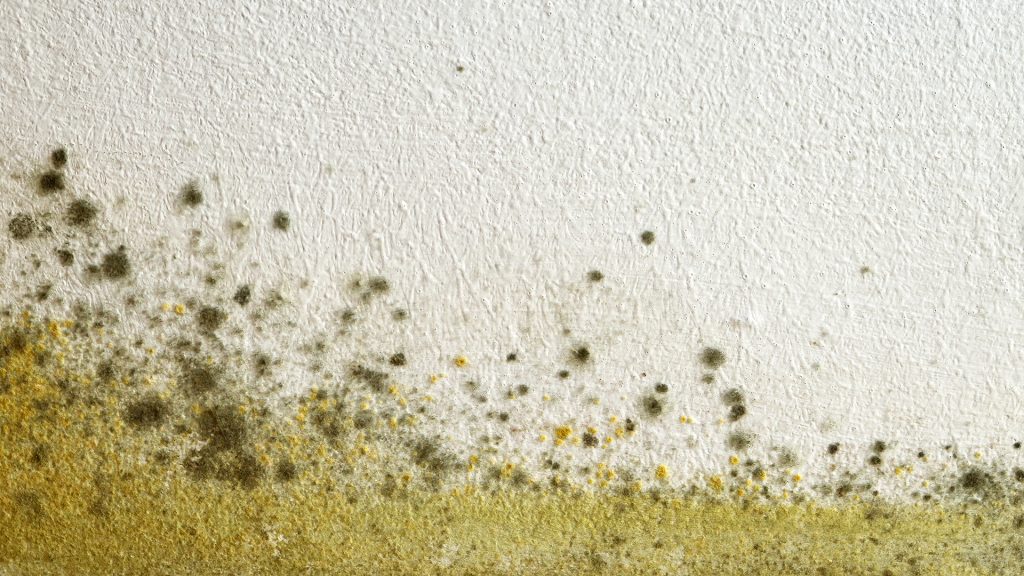Spectrum Blue introduces various antibacterial coating solutions to stop the growth of mold and fungi and reduce the risk of infection in various environments.
Mold is an amazing biology. It is very rough, and even a vacuum and extreme radiation spaceship can grow anywhere. Because we have a warm and damp climate, it is more expanded. It is dangerous for human health and destroys material perfection. How do I stop and protect unnecessary mold growth?
What is mold?
Mold is a kind of fungus that grows in a polyhesical filament called hyphagel. It is a natural part of the environment, and can be found almost anywhere with moisture and oxygen. Mold plays an important role outdoors to disassemble dead organic matter, but indoors can be a problem.
Mold is very common in houses and buildings. In the 2017 survey, mold was studied in all public buildings, with an average of about 14 mold instances for each building. With this wide range, the mold is an important issue for the owner and resident of the building.
Build a mold free future for home and workspace
The growth of mold in the indoor environment can cause serious risks, from structural injuries to health problems such as allergies and respiratory problems. In order to work on this task, experts emphasize the importance of controlling moisture, maintaining beautiful surfaces, and improving the energy. However, the conventional method provides temporary solutions, but innovative technology is currently providing permanent protection.
Work on moisture and ventilation
Moisture is the root cause of mold. Leaks, condensation, and poor drainage create a breeding ground that is optimal for fungi. It is the first step that is indispensable to fix the appropriate waterproofing and leak quickly and secure good external drainage. Inside, the HVAC system, which is properly maintained, can help adjust the humidity level and improve airflow. Appropriate filters and regular cleaning can reduce mold spores in the air.

Role of cleaning and disinfection
Daily cleaning is important for controlling mold in wet areas and areas with a lot of traffic. Natural disinfectants such as hydrogen peroxide and vinegar are effective in removing mold from the surface such as tiles and grouts. However, even the most diligent cleaning cannot prevent spores from returning, so you can only deal with mold temporarily.
Need for long -term solutions
It is important to manage moisture and daily cleaning, but it is necessary for constant efforts and vigilance. The mold is a way to prosper in an invisible corner, or after missing several cleanings. To create a truly safe, healthy and sustainable indoor space, you need a more permanent solution.
Q Field Coating: Mold Defense for 24 hours a day.
The Q-Field, a SPECTRUM BLUE innovative photocatalyst coating, offers a permanent solution for mold prevention. Unlike the conventional cleaning method and coating that worries over time, the Q field uses visible light to activate antibacterial characteristics and continuously remove bacteria, fungi and viruses. The walls, ceilings, HVAC ducts, and Q fields applied to other surface form a protection barrier to converting the indoor environment.
Q-Field provides a safer and sustainable indoor environment by reducing mold growth and reducing energy, constant cleaning or dehumidification energy demand. It’s not just a solution. We are moving forward to creating more healthy space for home and workplace.
The Q field integrated into the paint has protection for 24 hours a day, 24 hours a day. Click here for the effects of the Q field.
Bygdøymuseum case
Pilot test of more safe space: Antibacterial coating at the Oslo Maritime Museum
The Norwegian Maritime Museum in Oslo is famous for its abundant collections of marine crafts, a collection of collections, and creates a safe and healthy environment for visitors and staff. I am always exploring. In collaboration with SPECTRUM BLUE, the museum conducts a pilot test for advanced antibacterial coating, which is part of the Safer Spaces product series. This coating is also known as Q-paint and is enhanced with Q-field particles. This is a state -of -the -art technology that has been proven to significantly reduce mold, bacteria and viruses. As a result of success from clinical tests, the pilot program shows an exciting steps to investigate the potential advantages of Q-Paint for the operation, sustainable, and public health.
Pilot test with a proof of effectiveness
The Q -Paint incorporates a photocatalyst for disassembling harmful microorganisms when exposed to light. This technology has already demonstrated its excellent effectiveness in the laboratory environment and has surprisingly succeeded in reducing microorganisms on various surfaces.
As part of the pilot project of the Maritime Museum, Q-Paint is applied to selected areas in the museum, such as walls and ceilings. This test provides a unique opportunity to evaluate the performance of the real world of coating in the museum environment. The museum accepts this opportunity with enthusiasm, recognizes the possibility that this innovative technology will strengthen its saving efforts and contribute to the goal of sustainability.
Save artifacts and infrastructure
The preservation of marine crafts is the main concern of the Maritime Museum, where mold and moisture bring a great risk to the life of the collection. By applying Q-Paint, the museum has taken a positive step to prevent mold formation on the processed surface. Q. The photocatalytic characteristics of the field particles inhibit the growth of mold spores and bacteria, reducing the possibility of damage to valuable exhibits in the museum. This application does not only protect artifacts, but also contributes to the long -term preservation of the building itself.
With less mold -related damage, museums can extend the life of infrastructure, avoiding costs, such as replacement of walls and lipers, and destructive renovation. By reducing the necessity of these resource-intensive activities, Q-Paint also supports the environmental and economic sustainable initiatives of the museum, and that both collections and buildings remain excellent. Guarantee.
Public health and safety improvement
Beyond the protection of artifacts, Q-Paint offers great health benefits to museum visitors and staff. The coating Q -field particles work by eliminating harmful microorganisms such as bacteria, viruses, and mold spores when exposed to light. This technology guarantees that the treated surface remains independent of the pathogen, reduces the risk of infection and improves the overall indoor air in the museum. At venues, such as the Maritime Museum, which is the highest priority on public health, this technology provides effective and sustainable means to ensure a more secure environment.
Sustainability and cost reduction
Safe space antibacterial coating not only provides excellent protection, but also helps to reduce the impact and operating cost of the museum. The effectiveness of coating in preventing mold growth means that costly repair and renovation are required. This reduces the CO2 footprint in the museum by minimizing the resources and energy required to update the infrastructure. In addition, the antibacterial characteristics of Q-Paint reduces the need for frequent cleaning with harsh chemical detergents. The surface processed by Q-Paint must be washed occasionally with hot water and microfiber mop to reduce both cleaning costs and chemical use. This not only reduces operational costs, but also improves the health and safety of cleaning staff, and reduces exposure to potentially harmful chemical substances.
Joint approach to innovation
The Pilot test of the Maritime Museum’s Q-Paint shows a commitment to support innovation and sustainability in cultural sector. As “Proptech Museum”, this institution has improved the operation of museums and uses emerging technology that can contribute to the preservation of cultural heritage. This collaboration is mutually beneficial. The museum gains access to advanced solutions to enhance both the protection of artifacts and the visitor’s health. On the other hand, we will improve and expand technology in response to real world tests and feedback.
Conclusion
The Pilot Test of the Q-Paint, a more secure space series at the Oslo Maritime Museum, is an exciting step to save the museum and advance public health. Due to the proven validity of the laboratory test, Q-Paint offers great advantages, such as strengthening artifacts, improving public health, and decreasing the impact on the environment. By preventing mold, bacteria, and viruses, coating can help protect both cultural treasures and those who enjoy them. With the additional sustainable possibility of extending the life of infrastructure and reducing cleaning costs, QAINT is a wise investment for the future of the museum. Through this collaboration, the Maritime Museum has taken an important step in a safer, healthier, more sustainable museum environment, and has set precedents that other sectors should follow.
Case: Protect soldiers in military barracks with antibacterial coating
Mold and moisture -related issues in military barracks have long been a matter of concern, and have been documented by soldiers suffering from respiratory problems, nosebleeds, and reduced health due to exposure to mold spores. Some of the Norwegian barracks had to be abandoned due to the strictness of the invasion of the soldiers and the integrity of the building. In response to this important problem, our antibacterial coating, part of the Safer Spaces series, alleviates the growth of mold and protects both the health of the soldiers and the life of infrastructure. Is presented.
By applying Q-paint containing innovative Q-field photocatalyst particles to the walls and ceilings, the spread of mold and harmful microorganisms can be greatly reduced. Coating actively prevents the growth of mold, bacteria, and viruses, ensures a more healthy environment of soldiers, reduces the risk of respiratory problems, and promotes overall health. Furthermore, the ability to limit the growth of Q-Paint molds is not frequent renovation, resource-intensive repair is reduced, and ultimately saves costs, and associated with the rebuilding or replacement of infrastructure. CO2 footprint is also reduced. This will be an ideal solution for military facilities that try to improve health and sustainability while reducing operational and maintenance issues related to conventional mold control methods.
Case: Space Station and Space Ship: Protect humans in space
Space bacteria and -are real. A closed container with a recycling of human beings, food, biology, and space, air and water closing loop is a challenging environment that keeps clean and avoids microorganisms. 。 Q -field applications in the universe contain integrated coating and textiles with the Q -field in the spaceship, the universe, and the space base.
ESA has a project to stop the growth of microorganisms in the universe.
This article is also published in the 21st edition of Quarterly Publication.
Source link

